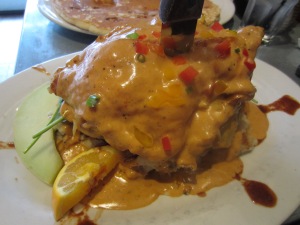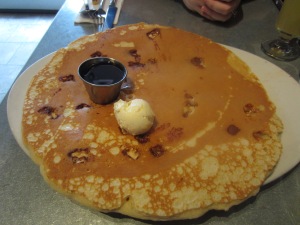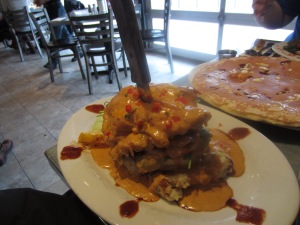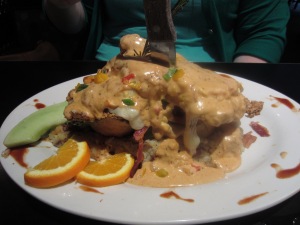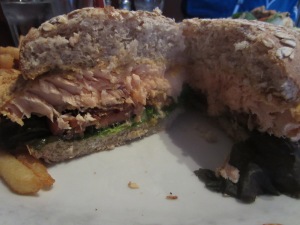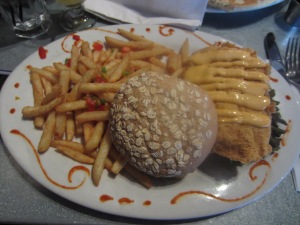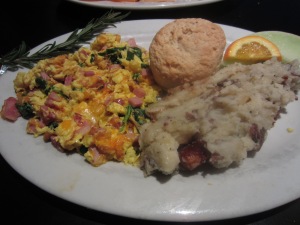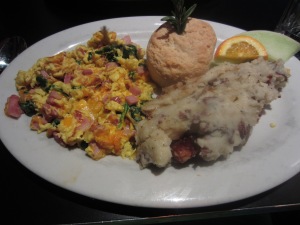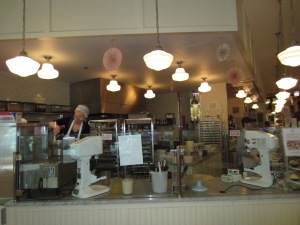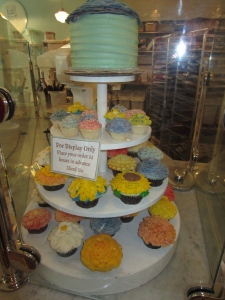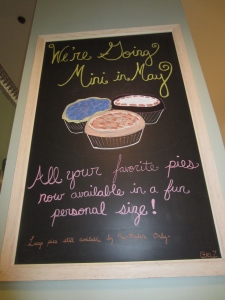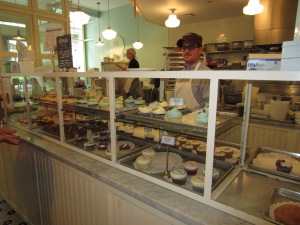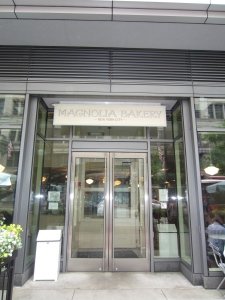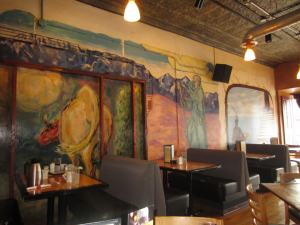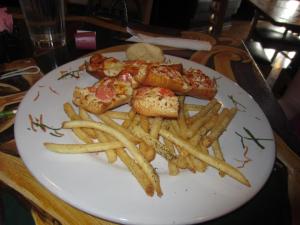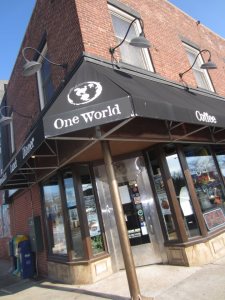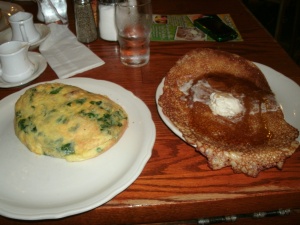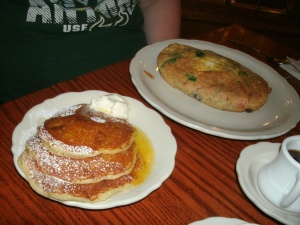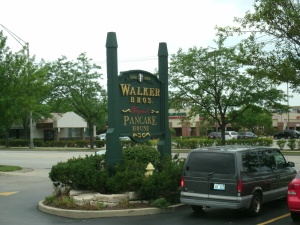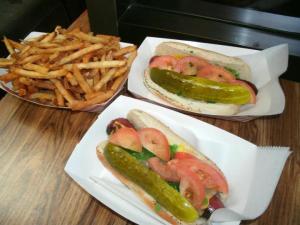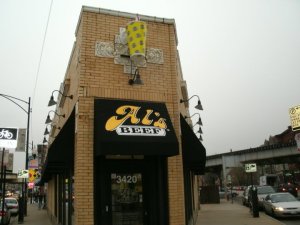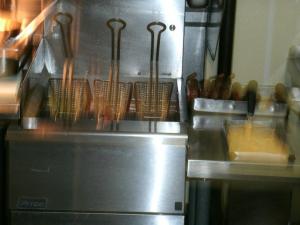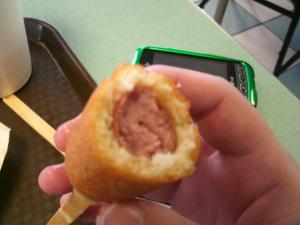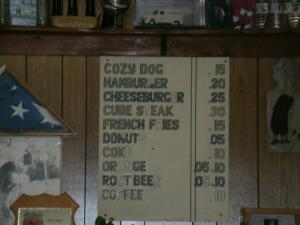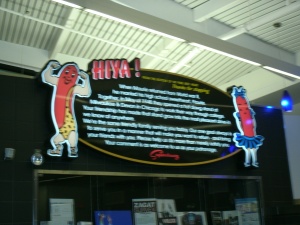Hash House A Go Go, San Diego/Chicago/Las Vegas
I’ll be honest: if I hadn’t taken a look at their website, I never would have guessed that San Diego is the original home of Hash House A Go Go. It’s not that the city isn’t known for great food. On the contrary, San Diego is an excellent food city, one that I hope to get to sooner rather than later. However, when one thinks of San Diego’s cuisine, what usually comes to mind includes seafood, Mexican, Asian, tri-tip barbecue and possibly pizza.
Creative farm food that specializes in the unexpected, on the other hand, seems to fit much better with Las Vegas, a city that goes all-in on doing the unexpected in an attempt to bring in the tourists and get them to leave without their money. Sin City is where I first encountered Hash House A Go Go, which at the time was located inside Imperial Palace, which might have been the best bargain on the Las Vegas Strip back in 2010 when I stayed there for three nights…and spent $54 total. Yes, an $18 a night hotel, one of the best things about Las Vegas.
Unfortunately, Imperial Palace no longer exists (it now operates under the name The Linq), but Hash House has done nothing but thrive in the 15 years since Craig Beardslee and Johnny Rivera came together to create a menu that includes creativity, uniqueness and some of the largest, most fresh and highest quality brunch items there are. That was true five years ago when I experienced it for the first time in Vegas, which made it one of the best breakfasts I’ve ever had when I experienced one of their scrambles in 2010. Ever since that, I’d wanted to get back to Hash House, and when I saw that its operations had expanded to Chicago, a mere three hours away from myself and Amy, I knew this was something that I needed to share with my lovely fiancee.
The first thing to know about Hash House is that they don’t do what’s expected here by any stretch of the imagination. Honestly, you wouldn’t expect the expected from a place that bills itself as “Twisted Farm Food”. For example, among their pancake roster, only the traditional buttermilk and apple cinnamon could be considered standard. The rest include options such as strawberry frosted flake, blueberry pecan, brown sugar banana, blackberry granola, butterscotch almond, mango coconut and Snickers. I can honestly say I’ve never seen any of those flavors with pancakes, even at the most creative breakfast places, which meant that these were a must-try.
However, the second thing to know about Hash House is that these portions are HUGE. We found out the hard way because as usual, we couldn’t decide between sweet and savory and decided to try both by each placing an order for an entree and sharing a Snickers pancake. Usually, this strategy has worked pretty well for us in the past. This time, however, the waiter laughed and said, “Are you sure about that order? That’s a lot of food.” Well, that’s quite a warning, but we decided that the idea was too good to pass up.
Turned out, he wasn’t kidding. Yeah, that pancake literally covers an entire plate that stretched from my spot to Amy’s beverage, and both of us immediately realized what we’d done as soon as the pancake came out. This thing is a meal in itself, which is why they charge $8 for it. You know, in retrospect, that was kind of a flashing neon warning sign that we were placing a breakfast order that might be enough to feed the state of Delaware.
But one bite told us that it was completely worth it, because this is one amazing pancake. The batter is light, fluffy and holds together beautifully, and the chunks of Snickers spread throughout put it over the top. I love the taste of chocolate and peanuts, and the combination basically turns this into a chocolate chip pancake with chunky peanut butter, which is something incredible. No, we didn’t come close to finishing because of how much we had in front of us, but we really, really wanted to, because this was incredible.
That said, it wasn’t even the best thing that we had, because this time, I knew that I had to try Hash House’s specialty: the sage fried chicken benedict. Yeah, there’s no part of that sentence that I didn’t like. What makes this thing special is pretty much everything, but it starts with what might be the best thing on the menu, the foundation of griddled mashed potatoes.
Yes, mashed potatoes placed on the griddle and cooked to perfection, giving them an extra crispiness while keeping the fluffy texture that always comes with good mashed potatoes. Plus, the flavors of the benedict soak into the potatoes, taking it to a higher level. With the potatoes in place, Hash House then adds biscuits, fresh spinach, bacon, tomato, eggs and fried chicken, the last of which is coated in corn flakes for a slightly sweet crunch. Griddled mozzarella is added, and then the whole thing is covered with a chipotle cream sauce.
Holy cow, this thing is awesome. The chicken is cooked perfectly and works beautifully with every ingredient, especially the chipotle cream sauce. The sauce penetrates every part of this dish, which creates both a creamy and spicy taste that creates the good kind of pain from start to finish. The bacon is cooked to Amy’s liking, hot and crispy, while the spinach, tomatoes and cheese help keep this dish from crossing the line from good pain to blistering regret. We’ve made two visits here now, with each of us going for this dish once because of how awesome it is. Of course, I’d be remiss if I didn’t mention the size of this meal, as this benedict is so gigantic that it needs a large steak knife to hold it all together. Pretty incredible.
On our first visit, Amy opted to go for the lunch side of brunch, opting for a salmon sandwich with chili mayonnaise, avocado and tomato. Sound simple? Maybe, but the taste is incredible. The salmon is wonderful with the cornmeal coating that they bread it with, and the chili mayonnaise works just as well with the salmon as it does with good sushi.
Throw in the wheat bread and the vegetables, and you’ve got a great experience that might actually be somewhat healthy at the same time, at least before you get to the mountain of fries that comes with it on what has to be described as an absolutely beautiful plate. That’s another sign of how they do things differently at Hash House, everything with the food is done perfectly to the last detail.
For our second visit, while Amy opted for the benedict, I decided that it was time to revisit the scramble I’d had five years earlier, opting for ham, cheddar and spinach along with my griddled mash. Honestly, that griddled mash is one of the best things I’ve ever had, with or without the benedict and the cream sauce. I’ve never once had one of the hashes here, mainly because those come with crispy potatoes instead of the griddled mash…and I’m actually someone who normally enjoys crispy potatoes/home fries over just about any other form of breakfast potatoes. These mashed potatoes are just that good.
So is the scramble, which is loaded with toppings from start to finish. The most important thing about a scramble is the balance between the eggs and the toppings. Too much of the eggs and the toppings get completely lost and might as well not be even there, while too many toppings cause it to be nothing more than a loose-jointed collection of toppings that lacks the eggs to hold them together. The proper scramble, therefore, features every element in the bite with the toppings each bringing something to the table. That’s exactly what happens here, as the fresh spinach and salty ham pairs well with the creaminess of the melted cheese and the flavor and texture of the eggs. It’s hard for breakfast to get better than this.
My one regret here is that unfortunately, in our two experiences here, the service simply has not matched the quality of the food. On both occasions, we’ve received a server who started off attentive, but eventually forgot we existed, forcing us to wait a while for drinks or ask other servers for help. That’s really sad for a restaurant of this quality to have issues with its servers like this, and it’s really the only flaw we’ve found here. Basically, we’ve yet to have a server that will be anywhere close to reaching the Jimmy Lopez Hall of Fame.
But when it comes to breakfast, Hash House knows what it’s doing for sure. From the griddled mash to the awesome scrambles to the sheer awesomeness that is the fried chicken benedict, there really isn’t anything here that’s going to be bad. No matter where it is, you can pretty much guarantee high quality food with a little creativity thrown in, and that’s a great way to start any day.
Recap
Time to go: Brunch. Although Hash House does stay open late in most locations and does have a dinner menu, it’s known for breakfast food. It does lunch well too, but breakfast is the star.
Wait during my visit: None. Sometimes you might have a wait, but we’ve been lucky so far.
Location: Hash House a Go Go’s original location is at 3628 Fifth Avenue in San Diego, while the location we’ve been to is at 1212 North State Street in Chicago. I’ve also been to the location inside what is now the Linq at 3535 Las Vegas Boulevard in Las Vegas, and Orlando and Uncasville, Conn., also have locations.
Cost: Expensive. The fried chicken benedict costs $15, and many other dishes check in at around $8-12. That’s high for breakfast, but it’s also very much worth it. Definitely plan on about $15-20 per person, though, and more if you care to partake in a mimosa or another of Hash House’s alcoholic beverages.
Parking: This will range from “available” to “don’t even think about it” depending on where you go. In Vegas, it’s definitely available but probably unnecessary. Here’s one thing to know about the strip: the casino wants you spending money on fun stuff, not boring stuff. That means games, shows, food, drinks, luxury accomodations and entertainment. It does not mean parking. I’m pretty sure that parking at Vegas casinos is always free on the Strip, and since the Linq is in the center, you can just park at your hotel and walk there if you’re not staying there.
In Chicago, there’s almost no parking to be had. Your best bet is to take the Red Line of CTA to the Clark/Division stop just north of the Loop, then walk two blocks east to State Street and head slightly north. Much more simple to do that than try for a spot on a Chicago street.
Seating arrangement: Tables, chairs and booths, depending on where you are in the restaurant.
Website: Hash House a Go Go
Specialty Items: Fried chicken benedict, scrambles
Magnolia Bakery, Chicago/New York
If ever there was an accidental find on this blog, this would have to be the one. Magnolia Bakery’s spot here isn’t because I saw it on the Travel Channel and decided I had to make a trip. It isn’t here because I found it on a “Best of” list or read a review in a newspaper, and it isn’t because of a high rating I saw online. It’s not even here because of its fame from Sex and the City, which I didn’t even know until I started doing some research.
No, it’s here because of a wrong turn that caused Amy to discover this place and decide that trying it was an absolute must. This blog is absolutely dedicated to my wonderful girlfriend, who found it on a trip into the Windy City while her mother and grandmother were in the Midwest for a visit.
Magnolia Bakery’s story is kind of the ultimate “keep taking shots until something hits the target” of the food world. Basically, this place started in New York in 1996, initially planning on simply baking bread and rolls. That plan didn’t work out because of space, so they moved their focus to cakes instead. That plan worked out fairly well, but when they made cakes, they realized that they usually ended up wasting a lot of batter. The solution became to turn the excess batter into cupcakes, and that proved to be the attempt that found the mark. New York, the city that a restaurant for pretty much every food known to man, had its place to get its cupcakes.
Showing just how much they had hit the target, Magnolia Bakery quickly capitalized on its newfound fame as being a cupcake destination in the world’s media capital. From their tiny beginnings, the bakery now has multiple locations in New York, a location in the Chicago Loop, one in Los Angeles and four in the Middle East.
Yes, for some reason, the Middle East loves cupcakes, so Magnolia Bakery has locations in Dubai (United Arab Emirates), Kuwait City, Beirut (Lebanon) and Doha (Qatar). Well, at least the people at the World Cup in Qatar in 2022 will be able to get good cupcakes, and I promise to stop with the soccer references. Anyway, there are plans to eventually add another 120 of these bakeries, and hopefully, some more of them will make their way to other locations in the United States.
The reason for the explosion is that these people know how to bake, and they use a lot of varieties. Their main seller is, of course, the cupcakes that made them famous, and they feature no fewer than 17 kinds of cupcakes, rotating flavors on a daily basis. Usually, only five will be available each day in the bakery, as they serve chocolate, red velvet, vanilla and the flavor of the month daily, plus one other that changes according to the day. But if you have a favorite, you can order any of their 17 flavors as long as you’d like at least a dozen of them. (Hmm, a dozen of something with creative flavors. That’s familiar.) They also do special designs, such as a stack of flower-shaped ones or cupcakes with Chicago Blackhawks logos as the team played for the Stanley Cup. Pretty cool.
Additionally, you can join their cupcake of the month club and get cupcakes shipped to your door. They pick the flavors, which means you’re going to rotate through possibilities like red velvet, pumpkin, peanut butter and jelly and s’mores, among others. Be warned, though, this doesn’t come cheap. One cupcake in the store is $3.50, and if you’re paying for them to ship the cupcakes to you, prices get really high. If you want six cupcakes a month for a year, you’ll pay a cool $500 for the privilege. If you’re doing the math, that adds up to $6.95 per cupcake.
Well, this is why you do your purchasing in the store. Amy opted for the a banana bread cupcake with chocolate buttercream frosting, and this was something special. Everything at Magnolia Bakery is made on-site with the freshest ingredients, which is pretty much the surest guarantee that you’re going to produce something that’s high quality. The cupcakes are moist and flavorful and the icing is perfect. You really can’t ask for much more than that.
Not knowing just how good the cupcakes were (to be fair, Amy didn’t know how famous they were either), I opted for something so different that I had to give it a shot. I don’t always choose peanut butter, chocolate and toffee as my dessert, but when I saw the peanut butter toffee bar, I knew that this simply had to be done. Basically, it’s like a brownie on steroids. Toffee and peanut butter are two of my favorite things in this world, and together, they produce a combination that is simply unbeatable. The flavors work together fantastically, and the texture is just perfect. I loved every bit of it, and definitely considered this to be worthy of our stop.
Along with the toffee bar, Magnolia Bakery produces other classic bakery items, like cookies, pies, cheesecakes and cakes. Along with our choices, her mother and grandmother added a caramel pecan mini cheesecake and a blueberry jamboree icebox pie, both of which looked outstanding. I’d like to say that I have taught her well, but the truth is, Amy always has been able to find good restaurants on her own.
This definitely proved to be another one, even if we weren’t even looking for something to put on the blog. Sometimes, you just have to keep your eyes open to what’s around you, because you never know what you’re going to find. These cupcakes were certainly worth the trip on their own.
Recap
Time to go: Anytime, really. Bakeries tend to move pretty quick, even when they do get crowded.
Wait during my visit: Not long, we moved through everything quickly. It took the longest time to decide what to order.
Location: Magnolia Bakery has multiple locations in New York and one in Los Angeles, but this one was at 108 North State Street in Chicago.
Cost: These are not cheap. Most items run about three or four dollars. But they’re really, really good.
Parking: Don’t bother. Take the CTA train on the Blue or Red Line into the Loop and get off at the last underground stop. I think it’s Washington for Blue and Lake for Red.
Seating arrangement: Small chairs and tables. If you’re on the bigger side, this could be a challenge and it might be best to just get your cupcake and eat outside.
Website: Magnolia Bakery
Specialty items: Cupcakes
One World Cafe, Peoria, Ill.
Of all the major cities I’ve been through, Peoria might be the one that I’ve been through the most, yet visited the least. The reasons are twofold. Interstate 74, one of the main roads used to get anywhere east of the Quad-Cities that isn’t Chicago, goes right through Peoria and over the Illinois River. Since a lot of my trips have led to east of the Q-C, that’s meant a lot of trips over the river.
The second, as you might have guessed, involves the love of my life. Because the airport in the Q-C never flies on the days we need it to, Amy often flies into Peoria when she comes to visit, which has led me to drive to the airport on three separate occasions, each time worrying that I’d oversleep and be late. Of course, this has never happened, I’m just paranoid on these kinds of things. However, the one constant is that up until this past weekend, I’d never stopped in Peoria.
Well, with Amy making her final trip into the Peoria airport, now was the time to get it done, and we couldn’t have picked a much better place to make our first real visit to Peoria than One World Cafe, located just outside the campus of Bradley University. What sets One World apart is that it literally tries to live up to its name, becoming a melting pot of restaurant styles, and it manages to pull it off. Instead of just focusing on one specific style of cuisine like most places do, One World offers entrees inspired by places across the world, putting their own spin on each one.
That’s a desperately tricky move to pull off, because attempting to specialize in everything can often lead to doing nothing particularly well. Instead, One World goes the opposite direction and manages to get its multitude of styles correct. Personally, I think it’s because of their commitment to fresh ingredients and a small, intimate atmosphere. One World’s founders started out by running a simple one-room coffee place, and they haven’t forgotten those early roots, keeping the place small and paying close attention to quality in the ingredients they use.
What that means is that you can combine several different styles, similar to Chino Bandido’s combination of Chinese and Mexican. One World doesn’t go quite that crazy, but it does offer choices from seemingly every continent on its menu. From its appetizers alone, you can find a choice from India (Samosa), the Mediterranean (hummus), Mexico (salsa and nachos) and America (spinach artichoke dip). What’s more, all of these are made with the best ingredients, often using high-brow options. The hummus, which Amy and I both sampled, is exceptional, using a family recipe of pureed chickpeas, lemon, garlic, salt, tahini, olive oil and paprika. There might be a few secrets in there, but the only thing I know for sure is that whatever is in there, it’s really, really good.
The worldliness continues with the entree, regardless of whether it’s breakfast or lunch. At breakfast, scrambles dominate the menu, as does the Bungle sandwich, a bagel with an egg souffle and either vegetables or meat between it. You can also opt for one of One World’s six specialty coffees, served either hot or cold and with or without caffeine.
While all of that sounds tempting, the fact was that it wasn’t breakfast, and besides, there was something else that caught my eye. Any time you get a chance to try an entree called “Bacon and Mushroom Chicken”, you pretty much have to take advantage of the opportunity, and that’s exactly what I did. Of course, this being One World, this was no ordinary bacon and chicken creation. This sandwich is topped with ranch and served on a tomato-basil focaccia bun, making for a high-brow taste with high expectations.
There was no disappointment here. The mushrooms are sauteed perfectly, the Swiss melts well on the chicken and the ranch dressing pulls it all together. Then there’s the bun, which does what a good bun should by actually imparting flavor and improving the quality of what it holds. The tastes of tomato and basil really take this sandwich to another level over the garden variety chicken bacon ranch that many restaurants have done a thousand times. Throw in some mashed redskin potatoes, and you have quite a meal here.
Amy chose to go for another One World signature, the tomato melt, featuring diced tomatoes mixed with spices to create something good. The main star on her dish was actually her pureed hummus, but the melt was a pretty solid backup. All in all, a strong food day.
Turned out, it was too strong, because our meals were so good that we missed out on One World’s huge desserts. All of their desserts cost $6, and looking at them through the display case as we walked out, these things look legitimate. The Reese’s peanut butter pie in particular looked heavenly and huge, and I had to promise the guy behind the counter that next time, I’d grab a slice.
That’s not a promise I would mind keeping whatsoever. Variety and a lot of choices might not always work well in the restaurant industry, but One World has found a way to perfectly blend the cuisines of several cultures into one menu that’s sure to please anyone who walks through the cafe’s doors, no matter what part of the world they’re from.
Recap
Time to go: Breakfast or lunch. Either one is good, as One World specializes in both. Do attempt to avoid the college crowd.
Wait during my visit: None. Coming in at 11:30 meant that Amy and I successfully avoided the lunch rushers and the college crowd, making us able to grab a quick table.
Location: One World is at 1245 West Main Street in Peoria, Ill.
Parking: Not good, but it can be done. There’s a small city-owned lot a little bit past One World, which is incredibly helpful. Without that, it would all be street parking, which suits nobody.
Cost: Most entrees are about $10-15. You should be fine with that, unless you throw dessert or a drink on the order.
Seating arrangement: Tables and chairs.
Website: One World Cafe
Specialty items: One cuisine across the globe.
Lou Malnati’s, Chicago
There are some foods that are so iconic that you don’t even need to attach a city to them, because they’re just so well-known in one area that everywhere else is considered to have copied your idea. Examples include hot chicken in Nashville, the Tampa version of the Cuban sandwich, Kansas City barbecue, Minneapolis’ Juicy Lucy or the pasty of Butte, Mont.
Chicago, of course, being the huge city it is, has three of these iconic staples. The first, of course, is the Chicago dog, which Amy enjoyed despite her distaste for anything that is beef. The second is the Italian beef sandwich, and the third and possibly most famous is the deep-dish pizza. Much like the Chicago dog, there are a lot of places who compete for the top spot in the Windy City at serving the upside-down pie, and it seems like nobody can agree on what the best actually is among legendary places like Lou Malnati’s, Gino’s East, Giordano’s and the nationwide chain of Pizzeria Uno.
Of those, I’m going to start with the one I consider the best (of the four, Pizzeria Uno will not be reviewed, as it’s across the country now) and the only one that Amy has experienced with me, and that’s Lou Malnati’s. The story of Lou Malnati’s is basically the story of a spin-off from the original. When deep-dish Chicago pizza was created, it was at Pizzeria Uno in the 1940’s by a chef named Rudy Malnati.
As you might guess, Rudy Malnati was the father of Lou Malnati, and the two men operated an Uno franchise until opening their own pizza place, Lou Malnati’s. The Malnati family still runs Lou Malnati’s today, so despite not being the first one to open, it’s technically the home of the original deep-dish pizza. For those who have never had it, deep-dish pizza is different from traditional pizza because of the order the ingredients are pieced together. I called it an upside-down pie earlier because the cheese is placed on the crust, then topped with meat and/or vegetables and finished off with sauce.
What this usually leads to is a royal mess, but at Lou Malnati’s, the mess isn’t quite as bad as at some of the other places, and I think it’s because Lou Malnati’s sauce seems a little chunkier than the others, as if the tomatoes aren’t crushed quite as fine. There’s still plenty of sauce, though, and it provides a great complement to one of Lou’s many pies. However, while you can get the standard pizza toppings here, there are two pies that are Lou’s originals.
The first is the Chicago Classic, which goes on the legendary Malnati Buttercrust, which is sworn on by Malnati fans. As the name implies, it’s a buttery flavored version of the deep-dish crust, which already provides a lot of dough. The Classic offers sausage with extra cheese and plenty of sauce, and they call it pure Chicago.
But even though neither of us are vegetarians, Amy and I lean toward vegetables on our pizzas (which sure did make our pizza puff experience a simple one back in January), and we are both particularly fond of mushrooms and spinach. So is Malnati’s, which called their second famous pizza, “The Lou”, throwing a basil-spinach blend with mushrooms and three cheeses and topping it with sliced Roma tomatoes.
This was heavenly. There wasn’t a sauce overload, there wasn’t the feeling of it being too hot for my mouth, there wasn’t too much of any one thing. This was an excellent pizza that was exactly what the deep-dish should be. Perfect amount of crust, perfect amount of sauce, lots of cheese, quality vegetables, filling meal. You can’t really ask for anything more. Both of us loved it, and we quickly decided that we had found our Chicago pizza place, so if anyone ever comes to visit us, that’s probably where we’re heading if we go to the Windy City.
The original isn’t always the greatest, because there are always people trying to top what’s been out there and improve on it. But in this case, the original has stood the test of time. There’s a reason this place has gone from having just two restaurants in the Chicagoland suburbs to 35 locations, several of which are in downtown Chicago. For great deep-dish, you really can’t go wrong with Lou Malnati’s.
Recap
Time to go: Lunch or dinner, and don’t come starving. Deep-dish pizza, because of the way it’s made, takes about 45 minutes, give or take a few, to cook. No matter how busy it is, you’ll be waiting.
Wait during my visit: Actually not bad, because funny enough, this is the one place where you WANT to come when it’s busy. One cool thing about Lou Malnati’s is that because it takes so long to cook the pizza, they allow you to place your order when you get in the restaurant, whether or not you have a table. What this means is that you can get your drinks and have your pizza cooking while you wait for a table to come free, and the result is that when you sit down, your wait on your pizza is likely down to about 15 minutes. Much more manageable. There are other options besides deep-dish if you really are starving, and they won’t take nearly as long to cook.
Location: Lou Malnati’s is at 35 and growing. Ours was on the Gold Coast at 1120 N. State Street in downtown Chicago.
Parking: Dream on. You can do it at the suburbs, but if you’re in the city, your best bet is to look up where the CTA trains go and get off at the closest stop to a Lou Malnati’s. We were a street away from our stop.
Cost: Beware the in-city tax. Chicago, being Chicago, is noticeably more expensive than its suburbs, and this is displayed by restaurants that have locations in both the city and the suburbs. City prices are likely to be a dollar higher than in the “land” portion of Chicagoland, which isn’t as bad as some other places, but plan accordingly.
Seating arrangements: Booths and chairs are both available.
Website: Lou Malnati’s
Specialty items: Deep-dish pizza
Walker Brothers Pancake House, Arlington Heights, Ill.
Apparently, I’m on a brothers run, as I’m following up Gray Brothers with Walker Brothers, which are of course in no way connected. But Walker Bros. does have a connection to something completely different. If you’re familiar with the movie Mean Girls, you might have heard of it because Walker Bros., found in the northern suburbs of Chicagoland, is referenced in the film, which I didn’t know about until later. In fact, I believe this is the first accidental find to make it on Dan vs. Food.
Basically, the lovely and amazing Amy McFann was visiting me, and our travel plans found us back near the Windy City for a weekend, which had brought us to Millennium Park and Superdawg the night before. That was the last Chicagoland restaurant from either Man vs. Food or the Chowdown Countdown that I hadn’t visited yet, so going into the next morning, in a rarity for us, we had no plans on where to eat the next day.
Well, that wasn’t going to work. We were in Chicago, which has a ton of great food, and we weren’t about to waste that opportunity. So I searched where we were and discovered high marks for Walker Bros., which was conveniently located less than a mile from where we were staying. Amy, who loves breakfast and pretty much any food that doesn’t involve beef or onions, easily agreed and we were on our way.
Upon stepping into Walker Bros., we quickly discovered that this was no ordinary accidental find. Walker Bros. has been named one of the top 10 pancake places in the country, and a look at the menu told me that I was at the North’s version of the Pancake Pantry. Walker Bros. doesn’t have quite as many as its Southern counterpart, but at 16 kinds of pancakes, the variety isn’t bad at all. Some of the kinds on the menu include the Swedish (with lingonberries), blueberry (with compote), bacon (I imagine that is wonderful with maple syrup) and Georgia pecan (nuts and sugar). They claim their specialty is the apple pancake, which is topped with cinnamon and a sugar glaze. Apparently, it’s so popular that it’s sold in freezers so people can have it at home.
That’s a pretty ringing endorsement. But I’ve seen apple pancakes before, and I’ve seen and sampled cinnamon pancakes before. That didn’t seem that unique to me, especially not when compared to Walker Bros.’ oven-baked omelets. I’ve eaten plenty of omelets in my life, usually with my favorite toppings of ham, mushroom and some type of cheese, with maybe another vegetable or two thrown in there. But I’ve never had one baked in the oven. To me, omelets are made on the griddle or in a skillet and folded over. Baking it? This I had to try.
One reason why we work so well together is that Amy and I tend to think alike, and she was as intrigued by the baked omelet as I was. Fortunately, Walker Bros. serves all omelets with your choice of three pancakes, allowing us the best of both worlds. With that in mind, I went with the classic spinach omelet and threw some mushrooms in there. As it’s normally served, the omelet is spinach with Cheddar and Swiss cheese, plus a mushroom gravy to top it with. But because I love the taste, my palate believes something is wrong with an omelet that doesn’t include mushrooms. Hence, a necessary addition.
With a nod to my brother Simon and my friend Erica, who are both huge San Francisco fans, I paired the omelet with the 49er’s Flapjacks, which are thin and chewy pancakes that melt in your mouth, especially when you pour on the syrup. Thin pancakes seem odd at first, but these are wonderful. The texture honestly feels like it’s gooey rather than doughy, and the taste is fantastic. Easily some of the best pancakes I’ve had. The real star, however, was the omelet. Spinach, mushrooms and cheese just goes together, and the oven gave the omelet a nice crust that made the inside simply perfect. The omelet holds together perfectly, it’s cooked to exactly the right texture, the flavors work great in combination with each other and it tastes incredible. Throw on some of the mushroom gravy and it couldn’t be better.
Amy, a lover of Greek cuisine, opted for the Mediterranean omelet, which features feta cheese, spinach, tomatoes, oregano and Greek olives. It also normally includes onions, but as you might have guessed, those were excluded at her request. She added banana pancakes to her order, which are quite excellent from my one sample of them. Her omelet was also excellent and enhanced by the mushroom gravy as well, which normally does not come with the Mediterranean. Luckily, they give you plenty of gravy when you order one that it does come with (you pour it on yourself), so we had enough for both of us. I’m not sure why they don’t include it with every omelet, but that’s about the only thing wrong here.
Breakfasts aren’t the thing Chicago is known for culinary-wise, but the Windy City and its suburbs know how to get the first meal of the day correct as well. There’s a reason that this place has been around since 1960 in a market as demanding as Chicagoland, and it’s quality. The northwest suburbs aren’t necessarily easy to get to, but for this, they’re worth the trip.
Recap
Time to go: Breakfast, although all locations are open until evening. Breakfast is just what it’s known for doing best.
Wait during my visit: Somewhat lengthy. The popularity is huge, so you can expect to wait about 15 minutes or so for a table.
Location: There are six. We visited the Arlington Heights location, which is at 825 Dundee Road in Arlington Heights, Ill.
Parking: There’s a nice amount. You’re not in the city, so you can park.
Cost: On the high side for breakfast. You’re probably going to pay about $15 a person.
Seating arrangement: Mostly chairs.
Website: Walker Bros.
Specialty items: Pancakes, omelets
Hot Doug’s, Chicago
When I told my brothers Simon and Zach the name of the place I’d stopped for lunch in Chicago before heading to O’Hare and boarding a plane to join them in Massachusetts for a New England Patriots game, both of them thought I was making it up. Turns out that in one episode of the King of Queens, always-hungry protagonist Doug Heffernan suggested to a hot dog place’s owner that he should change the name of his restaurant to Hot Doug’s, and my brothers thought it was a joke off the episode.
But Hot Doug’s is no joke in Chicago. It’s one of the city’s best places to enjoy the world of sausages on a bun, in a city known for its hot dogs. While Hot Doug’s keeps to the traditional toppings of Chicago on its sausages, it goes far above and beyond the standard Chicago hot dog. The best way to put it is that Hot Doug’s is, depending on your cuisine of choice, the Vortex, Voodoo or Ike’s of the sausage world.
In addition to the standard Chicago dog, Hot Doug’s expands to Polish sausages, bratwurst, Italian sausage, chicken sausage and several others, all served on the standard bun and topped with any or all of the condiments you find on a standard Chicago dog. For those who don’t know, that means mustard, relish, tomato, dill pickle, onions, celery salt, possibly peppers and absolutely no ketchup. Hot Doug’s is not nearly as strict on that rule, as you can easily use the ketchup available for the fries on your sausage if you so choose.
But that’s only the beginning. Each day, Hot Doug’s cycles through a plethora of high-brow sausages, some of which nobody would ever think of them as ending up in a sausage. Examples on one day include a portabella mushroom and Swiss pork sausage with anchovy mayonnaise, shiitake mushrooms and caramelized onions, a jalapeno and Chardonnay rattlesnake sausage (yes, rattlesnake) with fig cream and Dutch cheese, ale and Provolone chicken sausage with four-cheese dijonnaise and duck confit and foie gras and sauternes duck sausage with truffle aioli, foie gras mousse and fleur de sel.
All specialty sausages come with their own toppings that you will not find on the standard Chicago dog, making for a totally different experience than what you will find elsewhere in the city. However, different experiences had to wait for another day on my visit. The true test of a place is when you have something else to compare it to, so I had to sample some of Hot Doug’s more typical sausages to see if the ridiculous line on a snowy January day was justified.
It is. Both sausages have a great amount of juiciness and firmness, providing a great taste from first bite to last. The toppings all work perfectly with the meat, and the poppy seed bun is an excellent finish. The grilling of the meat adds a nice charred flavor, and the taste makes it clear that you’re in hot dog heaven.
That doesn’t even touch on the other specialty at Hot Doug’s: duck-fat fries. The use of duck sausage means that twice a week on Friday and Saturday, Hot Doug’s cooks its fries in duck fat and offers a large portion to its customers. The taste is excellent, and the fries seem to taste a little closer to the pure Russets that they came from. The skin is clearly still on, always a big plus.
No matter what your sausage preference is, Hot Doug’s can put something on a bun to satisfy any palate. Doug Heffernan might not have gotten his restaurant named after him in Queens, but he’d be proud to share his name with the sausage superstore of the Windy City.
Recap
Time to go: Lunch only. Hot Doug’s is open from 10:30 to 4 p.m. six days a week and closed on Sunday. Shoot for Friday or Saturday if you can to try the duck-fat fries.
Wait during my visit: Substantial. Hot Doug’s is so popular that even on a snowy day in the middle of January, the line was out the door. Do not go if you are in a hurry. You want to set aside time to eat and enjoy.
Location: Hot Doug’s is in the northwestern part of Chicago, at 3324 N. California Avenue.
Cost: Depends. A normal sausage will set you back only about $3. A specialty sausage is going to run you $8. It’s up to you which way you want to go.
Parking: I did it wrong last time. There’s a lot here, but I didn’t know that and walked a mile from the Blue Line on CTA. I do not recommend that anyone do this ever, least of all in 25 degree weather. I didn’t think things through at all.
Seating arrangement: Could get dicey. It’s seats and stools, but the restaurant gets so crowded that finding space is a challenge. Find a table and don’t give it up.
Website: Hot Doug’s
Specialty items: Sausages, duck-fat fries
Al’s No. 1 Italian Beef, Chicago
It’s a good thing I got this trip out of the way on my first trip to the Windy City, because it’s the one of Chicago’s three iconic foods that Amy won’t touch because of her distaste for beef. Along with pizza and hot dogs, Chicago is also well-known for Italian beef, a sandwich that is native to Illinois, only venturing outside the Prairie State on rare occasions.
Most of these occasions have been when stands have been set up in Wisconsin or Indiana, as these states are close enough to Chicagoland that having the beef sandwiches there is an absolute necessity for residents of these places. But the sandwich is so popular that Chicago natives, after moving away from the Windy City, have taken it far away from the shores of Lake Michigan and set up shop selling them in places like Florida, Texas and California. There is even a website that tracks where people can find authentic Chicago Italian beef, with the sandwich now being available in 46 states.
So what exactly is an Italian beef sandwich? It’s a roast beef sandwich, with the beef sliced paper-thin, and the sandwich topped with any or all of giardiniera, peppers and beef broth, served on a thick roll of Italian bread. The bread has to be thick by design, because of the broth soaking into the bread, which would otherwise cause it to fall apart, similar to the Thurman Burger or the Polish Girl. The creator of the sandwich isn’t for sure, but the oldest known vendor of the sandwich is Al’s Italian Beef, which has been around since 1938.
Basically, the sandwich traces its roots back to before World War II, and likely comes as a result of rations. The founders of Al’s decided that if they could slice the beef incredibly thin, a slab of roast beef could feed five times as many people. From there, the sandwich was born. There really isn’t a lot to the sandwich in terms of complexity, which isn’t a bad thing at all. Every sandwich at Al’s starts with slow-roasted beef blended with Al’s own blend of spices before it’s sliced and loaded on the roll.
From there, you have the option of going with either a hot or sweet flavor to the sandwich, or even both. For those who like it hot, giardiniera is the condiment of choice. Giardiniera is kind of a mix of relish and mixed vegetables, with a little heat thrown in for good measure. Celery forms most of the base, along with vinegar, while other vegetables and spices are added to the mix to create the flavor. Sweet peppers are also an option, giving you a sandwich topped with a couple of the mild green peppers.
Finally, the sandwich is dipped into the beef broth, creating the need for the thick Italian bread mentioned earlier. Depending on how juicy you like the sandwich, it can be dipped just slightly, multiple times or it can become so juicy that even the Italian bread has trouble staying in one piece. I’m not sure who needs that much broth, but whatever works for you.
For me, what worked was one dip with sweet peppers. It’s a wonderful combination. The thin beef has been cooked to perfection, and when the juice is added to give it extra flavor and help the sandwich go down easier, it’s simply fantastic. Throw in the natural sweet and mild taste of the sweet pepper, and you have a sandwich that stays hot and juicy from start to finish.
I also have to say, you definitely need at least some broth on this sandwich. The beef is good on its own, but it’s the juices that really make this thing stand out. Without the juice, you just have a regular sandwich and fries that you could get at any sandwich store. With it, you have a true taste of Chicago. If beef is something you enjoy, you’ll find a great meal here.
Recap
Time to go: Lunch or dinner. Al’s does have a few locations that are open until well past midnight, but not all of them are. Check before you go.
Wait during my visit: None. Came right after a Chicago Cubs game, and was far enough from Wrigley that ballpark traffic was nonexistent.
Location: Al’s can be found all over Chicagoland. My location was in Wrigleyville, at 3420 N. Clark on Chicago’s North Side. Its site also says locations are coming to Las Vegas and San Jose.
Cost: You should be fine for around $10 here.
Parking: At some locations, there will be plenty. At others, dream on. This one falls in the “dream on” category. Your best bet for those in the city is to take the CTA train (everyone calls it the L for “elevated train”, but that looks confusing in print, so I stick with calling it CTA. Plus, the train isn’t always elevated, as the Blue and Red Lines both go underground. Accuracy counts to me.) to the closest stop and walk from there.
Seating arrangement: It’s chairs and stools here.
Website: Al’s Beef
Signature items: Italian beef sandwich
Cozy Dog Drive In, Springfield, Ill.
It might be the most well-known food item at fairs across the country. It’s probably the best-known food to ever be served on a stick, which wasn’t always the case. It’s the corn dog, an iconic part of American culture that really needs little introduction. Almost everyone has eaten a corn dog at some point in their life, because it’s the ultimate fair food, a comfort food that you can carry with one hand.
Who actually invented the corn dog is a point of debate, as three different places claim to have sold the first ones, which debuted around the time of World War II. If you’re in central Illinois, however, there’s no debate. It’s widely accepted there that the corn dog was invented in 1946 at what became the Cozy Dog Drive-In, and saying otherwise could lead to a fight in the state capital of Springfield. There’s also no debate because they don’t call them corn dogs at Cozy Dog. The call them, you guessed it, cozy dogs.
Outside of central Illinois, what is accepted is that Cozy Dog was the first to put the corn dog on a stick. Yes, hard to believe, but at one time, a corn dog was nothing more than a hot dog with batter instead of a bun. It was still dipped and deep fried, but customers held it the way they did a regular hot dog. Cozy Dog changed that by using tongs to impale the hot dogs before dipping them into the batter, which became their own special mix of the famous cornbread we know today.
Today, Cozy Dog uses the standard sticks, and uses a very nifty apparatus to load them and dip them into the batter. The hot dog is placed on the stick, and then loaded into a rack that was created by Ed Waldmire, the original founder of Cozy Dog. It’s then dipped in the batter and placed in the oil to be deep-fried, but it’s not dipped and fried until you order.
A lot of corn dogs made this way end up with the batter either being too soft and feeling like a greasy pillow, or too tough and end up with a flavorless crunch. Not the case at Cozy Dog. When you bite into the cornbread batter, it’s crispy on the outside, soft on the inside and tasty all the way through. The cornbread comes out a pure golden brown, which is always a good sign. Plus, the hot dogs have the spice and snap of a good sausage, adding an unexpected and welcome level of flavor.
You might remember from Superdawg that in Chicago, ketchup is never allowed on a hot dog. That isn’t the case at Cozy Dog, because the cornbread has a sweetness that works as a natural partner to the ketchup, which is known for being a sweeter condiment. On a regular hot dog, the ketchup’s sweetness overwhelms the non-sweet hot dog and more tart and spiced toppings that are accepted. But when it’s already sweet, it’s merely a delicious and acceptable complement to the bread and meat. Of course, if you can’t bring yourself to add ketchup to a hot dog in any situation, mustard is available, and the Cozy Dog is very delicious plain.
Along side it, Cozy Dog also serves high-quality fries, cooked skin-on the way good french fries should be. They’re a great addition that make it a full meal. The corn dog has come a long way since its introduction, but simple is sometimes better in the culinary world. Their way has worked for nearly 70 years at Cozy Dog, and a trip here always feels a little like a visit to the fair.
Recap
Time to go: Anytime between 8 a.m. and 8 p.m. on Monday through Saturday works. Cozy Dog is not open on Sundays.
Wait during my visit: None. Springfield is not exactly Chicago, and you won’t have to fight huge crowds.
Location: Cozy Dog is on what was part of historic Route 66. It’s located at 2935 S. Sixth Street in Springfield, Ill.
Cost: OK, it’s not 1946, so you can’t get a Cozy Dog for 15 cents anymore. But these prices aren’t bad. Two Cozy Dogs with medium fries and drink cost about $8. Not quite Aguila Hall-worthy, but not bad.
Parking: Not bad. The lot isn’t big, but it’s Springfield.
Seating arrangement: Tables and chairs
Website: Cozy Dog
Signature items: Cozy Dogs
Superdawg Drive-In, Chicago
We’ve touched on the pizza of Chicago before, but they take their hot dogs just as seriously in the Windy City. The Chicago hot dog is legendary to people who have never set foot in Illinois, and several Chicago landmarks will include souvenirs that say what goes on a standard hot dog, and what should never go on a hot dog.
Each place has their own way of doing it, but it’s generally accepted that ay Chicago hot dog includes mustard, sweet relish, onions, a dill pickle and a dash of celery salt on a poppy seed bun. The hot dog may or may not include sliced tomatoes, but absolutely never includes ketchup. In Chicago, ketchup on a hot dog is seen as a sin, and many vendors will not put ketchup on the hot dog. If a customer wants ketchup, they are either refused or handed a bottle and told to apply it on their own, because they believe ketchup ruins the taste.
The latter is the route taken by Superdawg Drive-In, which is one of the most iconic places in Chicagoland to get an authentic Chicago hot dog. Superdawg has a few differences from the standard places to get a Chicago dog, the most obvious of which is the ability to have car service, similar to the 1950’s. Superdawg offers the standard ability to eat inside the restaurant, or you can simply order your meal from your car, as you do at Sonic. The other obvious difference is the two iconic Superdawg figurines on the restaurant, designed in honor of Superdawg’s founders.
Once you get ready to place your order, make sure you’re using the correct name. The restaurant is proud of its hot dogs, so much so that they do not call them hot dogs. They are always referred to as Superdawgs, and the employees will inform you of this if you call it a regular hot dog. The Superdawg, like all true Chicago dogs, is an all-beef hot dog, placed on a poppy seed bun. The frank has a hint of garlic in its flavor and has a bit of resistance in its casing when you bite into it, like a good sausage would.
All toppings on the Superdawg are optional, but if you choose to get them all, you’ll find mustard, sweet relish, a dill pickle spear, hot peppers, onion and celery salt on a poppy seed bun, along with a green tomato on the side. I’m not sure why they used a green tomato, or why it’s not on the Superdawg itself, but that’s the way they choose to do it. The green tomato isn’t obvious as a part of your order, but it is there for a reason, along with your fries that surround the dog.
Probably the best way to describe the quality of the Superdawg is that my lady Amy McFann, who hates the taste of beef in all its forms, enjoyed her Superdawg, which served as her first experience of the Chicago dog. While she was willing to try the all-beef dog, she does have her limits and chose to pass on the onions. I went without the peppers, which is a good decision for me because as we’ve seen before, I’m not much for heat.
Even without the heat, the Superdawg is super. The hot dog snaps well and provides a juicy texture in every bite, and the condiments work perfectly with the meat, which is exactly what all good condiments are supposed to do. With a side of crinkle fries and ketchup to pair with those (the only real reason Superdawg even has a ketchup bottle), it’s a perfect meal at any time of the day.
When you stay in business for decades, it’s a great sign. When your business was around from the carhop days and still has them in service, that’s an excellent sign, especially in a town that demands as much from their dogs as Chicago. Superdawg is definitely worth the drive.
Recap
Time to go: Late night is perfect. Superdawg opens at 11 am and stays open until 11 pm at their northern location and 1 am in the city, with both extended an extra hour on weekends.
Wait during my visit: None. This happens when you go at night.
Location: Superdawg is found at 6363 N. Milwaukee Avenue in Chicago and 333 S. Milwaukee Avenue in Wheeling, Ill., north of Chicago proper. We visited the second location.
Cost: A Superdawg and fries with drink costs about $7.50. I’m putting them in the Aguila’s Sandwich Shop Hall of Fame for cost.
Parking: Plenty. Unlike the rest of Chicago, driving here in encouraged because of the car service, which is optional.
Seating arrangement: Inside the place, it’s chairs and stools, with room to sit.
Website: Superdawg
Signature items: Chicago-style hot dogs
Lucky’s Sandwich Company, Chicago
As far as sports bars go, it doesn’t get much better than Lucky’s, located within walking distance of Wrigley Field, the home of the Chicago Cubs. There’s just something about being located in Wrigleyville that makes a sports bar that much cooler, unless of course you happen to be a fan of the Chicago White Sox or St. Louis Cardinals, who probably see nothing cool about it.
Sports-wise, it doesn’t stop at baseball. Lucky’s is also a destination for Chicago Blackhawks fans, so it does know some sports success with the Hawks’ 2010 Stanley Cup, despite being in the shadow of a ballpark where you walk in and realize just how much history hasn’t happened there (Wrigley Field was built in 1914. The Cubs last won the World Series in 1908) in its long career.
But Lucky’s is more known for its culinary success. Basically, this is the restaurant that brings the taste of Pittsburgh to the Midwest in the form of the overstuffed sandwich. For those who aren’t familiar with the Pittsburgh institution Primanti Bros., it created the overstuffed sandwich when it added fries and cole slaw to its sandwiches, giving people who needed to use one hand a chance to eat with the other by putting the sides on the sandwich.
Lucky’s got its start when a Pittsburgher came out to the Windy City and brought the food he loved to his new hometown. The result was that Chicagoans got yet another food to be proud of in a city that boasts the Chicago hot dog, deep dish pizza and the legendary pizza puff.
Like at Primanti Bros., all sandwiches at Lucky’s come with your choice of meat, along with cheese, cole slaw, tomatoes and french fries placed on the sandwich. It’s 4 ounces worth of standard deli choices, with selections such as turkey, ham, roast beef, pastrami and capicola dotting the menu, all of which is grilled before being added to your sandwich. Fish, bacon and chicken can also be had, and so can a two-bagger, which includes pastrami and corned beef.
Not only do some people swear by that sandwich, but it’s also one that isn’t on Primanti Bros.’ menu, one of the subtle differences between the original and the Midwest version. The biggest difference between the two is the type of bread they use to hold all of their ingredients together. While Primanti Bros. goes for a standard-cut Italian bread, Lucky’s opts for a thick cut of French bread, which holds the sandwich together quite well and goes very well with the ingredients.
Another small difference is the Lucky’s Challenge, created when a drunk stumbled into the building with an appetite and began consuming sandwiches. In an hour, he put down three sandwiches, and Lucky’s walls are now filled with pictures of those who have performed the same feat. I do not recommend trying this, because these sandwiches are huge. Personally, I’m just fine knocking down one sandwich, but any beyond that and I’d be in trouble. Those with smaller appetites, like my girlfriend Amy, will struggle to finish one. During our trip to Chicago in the winter, she finished about half a sandwich.
Should you decide to try it, you’d be given the option to choose whatever three sandwiches you wish, usually with an egg added to them along with the standard sandwich. I do recommend the egg, because it adds another element of flavor, and at just 50 cents for it, it’s worth the price. I’ve had the ham and cheese and the turkey and cheese, each time with the egg, and it’s definitely been a great addition.
If you want the original, you’ve still got to go to Pittsburgh. But for an imitator, Lucky’s has done quite well for itself, turning into a beloved part of its chosen city in its own right. Imitation is considered the sincerest form of flattery, and Lucky’s form of flattery does its originator justice.
Recap
Time to go: That depends on what kind of atmosphere you want. If you want it loud, busy and raucous, go on a Cubs game day. If not, check the baseball schedule first and avoid days when the Cubs are at home.
Wait during my visit: Lengthy during a visit when the Cubs played at Wrigley, minimal when I returned in January. Basically, how long you wait is determined by whether or not the North Siders have a home game.
Location: Lucky’s main location is at 3472 N. Clark Street in Chicago, specifically Wrigleyville.
Parking: Dream on. Wrigleyville does not have many places to park, as it’s a neighborhood in Chicago. Your best bet is to take the CTA L train’s Red Line to Addison and walk to Lucky’s. It’s about a quarter-mile walk from the CTA station.
Cost: Almost all Lucky’s sandwiches are $7.50.
Website: Lucky’s
Specialty items: Overstuffed sandwiches.
